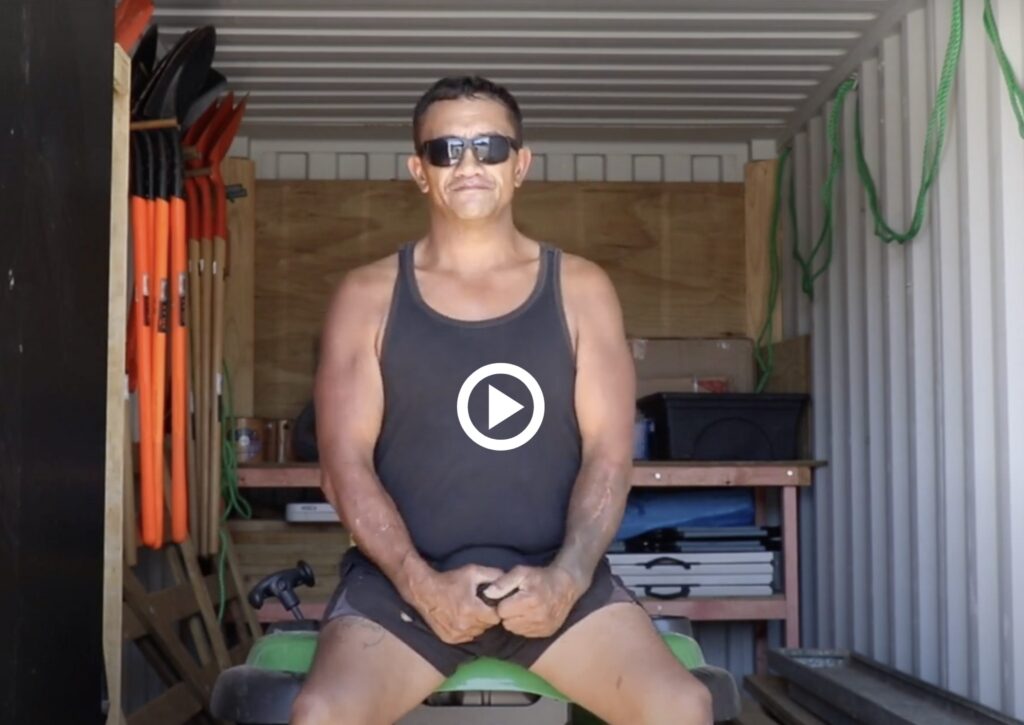Fostering Active Citizenship — Learning from Taranaki
The individual awakening of citizenship is a critical element in how our communities
develop – because this awakening involves figuring out just what part of making
things better has got your name on it.
vivian Hutchinson 2012
Active Citizenship is term we’re hearing more about and it’s a key foundation of effective community-led development. How Communities Awaken – Tū Tangata Whenua is an award winning four-month Masterclass for active citizenship first established in Taranaki in 2011 now operating as a partnership between Community Taranaki and Tū Tama Wahine o Taranaki. Around 350 people have now participated in the Masterclass process, which has evolved a learning approach based on tikanga Māori, wānanga and community-led adult education practices. As a result, a diverse range of community members have now embraced their citizenship, developed a shared language, and formed strong networks across their community.

Masterclass participants deep in conversation.
Photo credit: Tū Tama Wahine o Taranaki
But what is Active Citizenship? For Masterclass co-founder, vivian Hutchinson, it’s “about finding purpose, place, relationships, and personal meaning through asking big questions and engaging in deep conversation with others.”
The Taranaki Active Citizenship Masterclass process has come about through skilful curation and longstanding, trusting relationships between vivian and the whanau behind Tū Tama Wahine o Taranaki. Awhina Cameron, CEO of Tū Tama Wahine o Taranaki, highlights the significance of friendship as the foundation for the collaboration. “Like any small community you can have MOU’s and service level agreements, but the reality of how it works is through friendship and whakapapa. Our work with vivian is an example of this. He was mentored by some of our late, great aunties.”
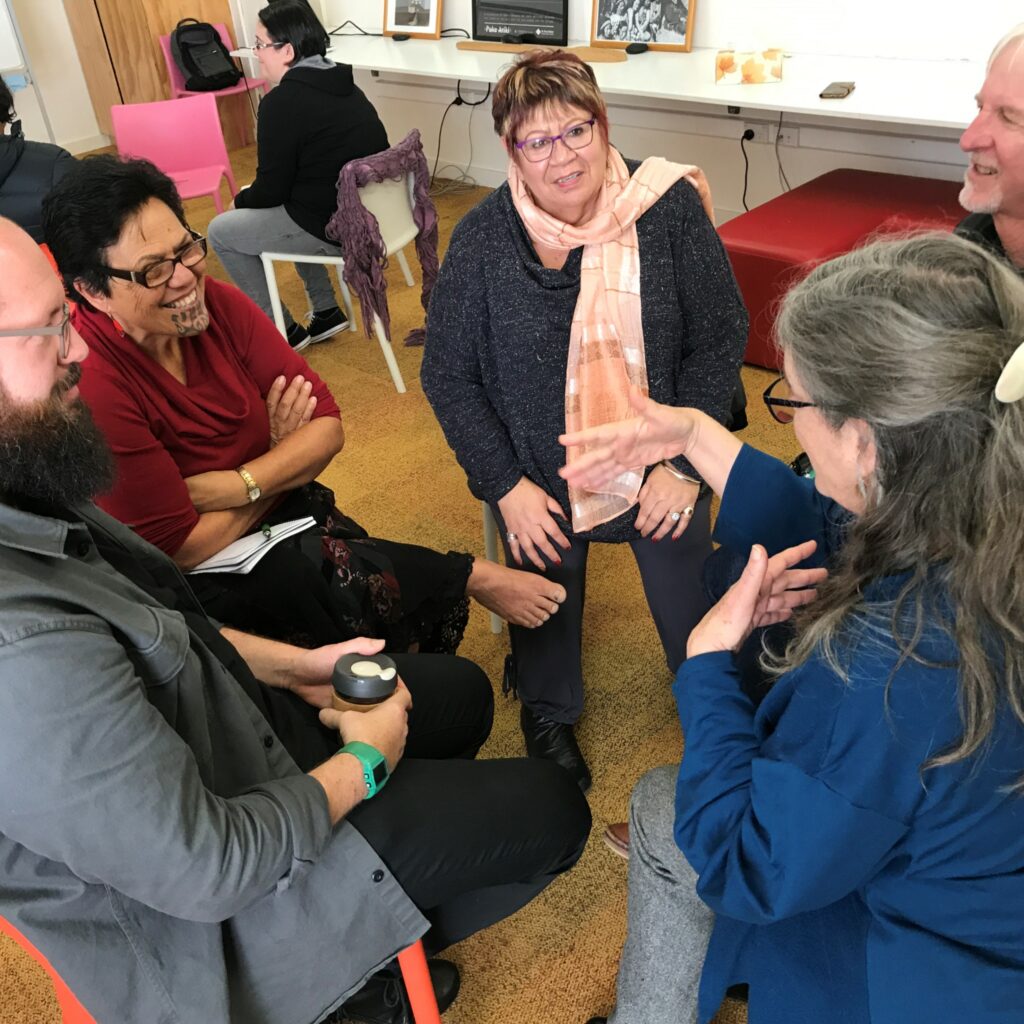
“The Masterclass really made me stop and re-analyse all my work, particularly the place of social services versus real community engagement.”
“I will now approach my group work much slower. I won’t rush in and fix the problem, instead I will try to think outside the square and use a more inclusive approach.”
Feedback from Masterclass Participants
Photo credit: Tū Tama Wahine o Taranaki
Masterclass fundamentals
The concept of invitation and intentional participation is core to the Masterclass approach. vivian notes “the personal invitation to participate helps to curate a diverse network.” People come and choose to become part of the process due to this invitation. Unlike many traditional learning opportunities, individuals are invited to attend as themselves, not as a representative of an organisation or other entity. Awhina adds that this invitation crosses boundaries between work and citizenship – and for many it is an awakening of new ways of thinking.
The Masterclass is a process of conversations. Participants are encouraged to listen and delve deep, listening to stories, considering key questions, and sharing in large and small group circle-based conversations.
Every class is different. I expect to learn as much as I have to share.
vivian Hutchinson
The Masterclass topics of Invitation, Possibility, Ownership, Dissent, Commitment, and Gifts were first offered by the US author Peter Block in his book “Community – the Structure of Belonging” (2008). To this, the Taranaki team added conversations on Community, Citizenship and Action. Workshops on these concepts are held fortnightly, with participants gifted books and a wide range of other readings and resources to explore between. During each workshop, participants lead workshop content by sharing their own history and stories as an introduction to the conversation. Local elders and thought leaders are invited into the conversations to ‘stretch’ them by sharing their perspectives. In terms of Mātauranga Māori, these ‘stretches’ have included insights into Tū Tangata Whenua, Tikanga, Rangatiratanga, Whanaungatanga, Māramatanga, Ōhākī and Koha. (These links will lead you to Te Aka – Māori Dictionary meanings for these words.)
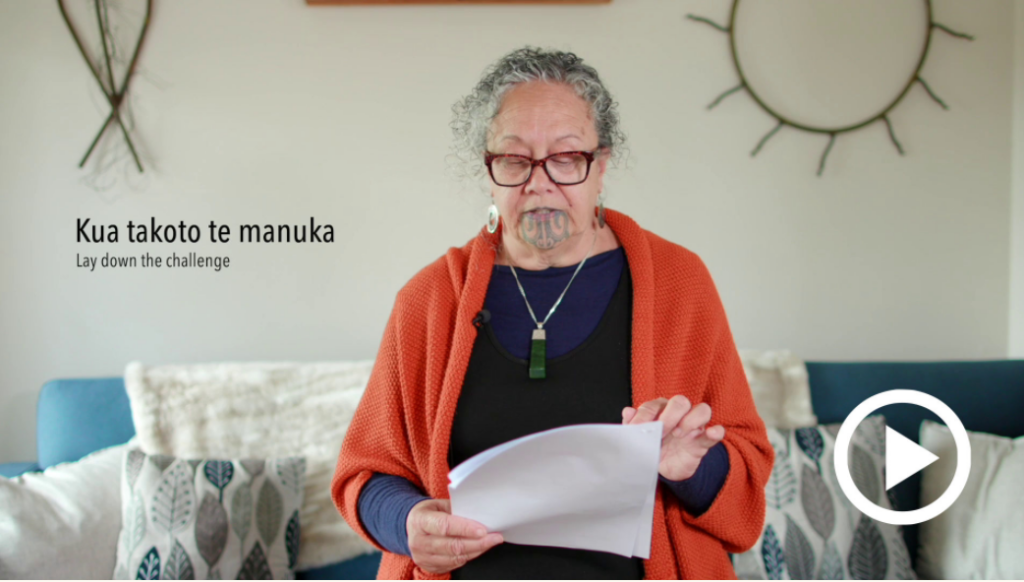
Ngaropi Raumati, Kuia and Director of Tū Tama Wahine o Taranaki has created Te Kai a Te Rangatira (2020) This video series is based on her stretch conversations on the topics above.
For many, it’s a challenging process. It invites a slowing down, actively listening and committing to a journey. Awhina notes that the Masterclass is not therapeutic, nor is it mentoring. It allows time and space for people to do some deep thinking about self and place in community, alongside and in conversation with others.
The Masterclass has made me ‘feel more like myself’ than I have for a long time.
Participant feedback
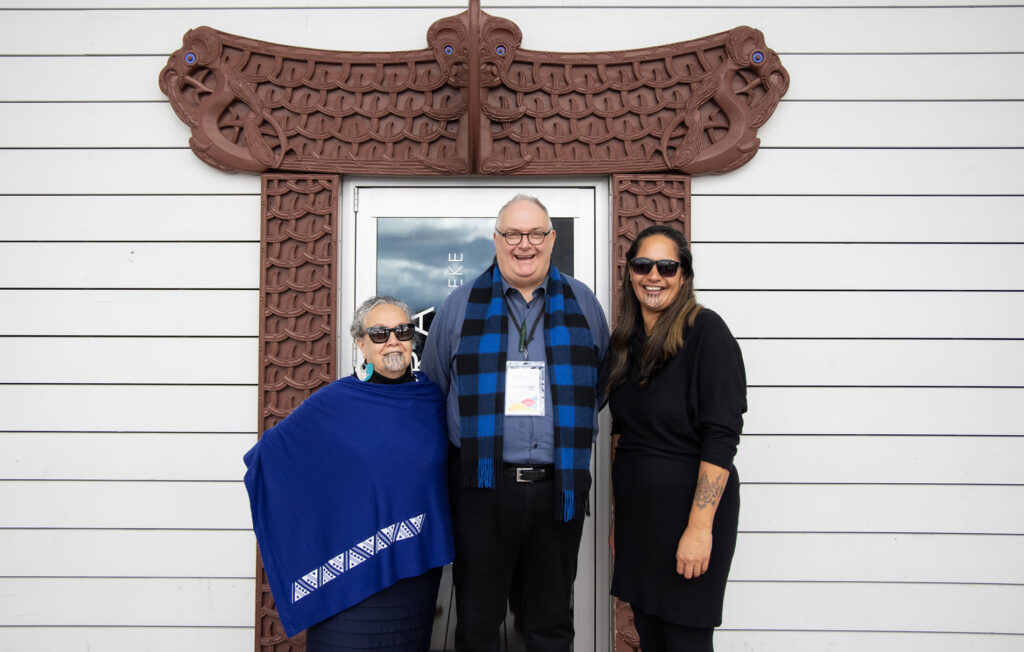
Ngaropi Raumati (Tū Tama Wahine o Taranaki), vivian Hutchinson (Community Taranaki) and Charissa Waerea (ACE Aotearoa) — pictured outside Te Raukura, Te Wharewaka o Pōneke, ACE National conference June 2021.
Photo credit: ACE Aotearoa
The Masterclass leads are careful not to claim praise for outcomes that have emerged for individuals who have been part of the Masterclass journey. They remain humble, and acknowledge that changes, activations, projects, and personal development belong to the participants, not them as individuals, or their organisations. Despite this, both feel a strong sense of positive community development in Taranaki because of the Masterclass process. Their success also formally recognised thorough the awarding of the 2020 ACE Aotearoa Annual Award for Community Programme of the year – Tangata Whenua.
An evolving bicultural approach
The Masterclass process, content and format has continued to evolve. A couple of years after the first conversations, Tū Tama Wahine o Taranaki wanted to become involved, but to do it their way required a bicultural approach vivian says. “This was easily done due to some long-standing relationships, over several generations. The trust was already there for creative collaboration.”
Awhina speaks of the advancement of Māori and indigenous ideas of community development and active citizenship that has happened through conversations over time. For an organisation like Tū Tama Wahine o Taranaki, it’s about walking in both worlds and having to translate concepts with a te ao Māori perspective. “This information wasn’t available at the beginning, it is content that we have had to think through, explore readings, look at other indigenous communities and land upon our own thinking”.
What’s changed?
You can’t operate in a community without being part of the community.
Awhina Cameron
Both vivian and Awhina enthusiastically explain that for them, the Masterclass has been the most profound, effective, and directly beneficial ‘professional development’ programme they have witnessed. Finding and opening-up space for deep conversations and reflection has led many participants to new insights on citizenship, belonging, cultural competence, assets that are latent in their communities and their own individual purpose and contribution to community. And for those working as service providers, the Masterclass has grown understanding about the need for people to be themselves, have space to think and find their purpose – that their work needs to be about more than just services says Awhina. “Having kaimahi, community members, clients and others all involved together in the Active Citizenship process, and as active citizens, thereafter, is contributing to the overall health and success of the community.”
Participants finish the Masterclass with an action plan for their own roles and direction as active citizens in the community. This has led to participants progressing a range of initiatives that hold meaning for them, from kaumatua group activities to mirimiri /massage for babies, to a community garden project, community gymnasium, and kapu korero sessions, where community members come together to practice their every day reo.
Sharing what’s been learned
There is tremendous knowledge held within the group and people were extremely generous in sharing their wisdom.
Masterclass participant
With Covid bringing a halt to running the Masterclass in person, the team has put their minds to other ways of sharing their knowledge.
Tū Tama Wahine o Taranaki and Community Taranaki have developed a written guide about the Masterclass as a step towards sharing this knowledge with other communities. This extensive resource is available on their website and was supported by the Department of Internal Affairs. Awhina emphasises the importance of asking questions and engaging in conversation, and offers a way of approaching the guide – “Ask, where is the relevance of this thinking, particularly around Māori concepts?”
Alongside the Masterclass Guide, Ngaropi Raumati, Kuia and Director of Tū Tama Wahine o Taranaki has created Te Kai a Te Rangatira (2020) video series based on her stretch conversations held in the Masterclass.
vivian has brought together a collection of essays on topics at the heart of Active Citizenship and published these into a book, How Communities Awaken — Some Conversations for Active Citizens (2021). The essays are freely available on the Community Taranaki website.
vivian’s advice for other communities looking to begin something similar is to make time and space to read and absorb the material. Like Awhina, he views the Taranaki Masterclass resources as a place to begin conversations and evolve from there. A useful start to creating your own Masterclass can be found in his paper, Some Elements of Design.
Get your thinking about Active Citizenship started!
Read the guide to the Taranaki Active Citizenship Masterclass
Watch Tū Tama Wahine o Taranaki’s “stretch” videos by Ngaropi Raumati which look at Active Citizenship from a Te Ao Māori lens
Read How Communities Awaken essays by vivian Hutchinson
In 2022, Inspiring Communities will share vivian’s essays on our social media. We are keen to open a wider national conversation about active citizenship, and ways to grow more of it across our communities. Please join us for this conversation!
In 2022, Inspiring Communities will share vivian’s essays on our social media. We are keen to open a wider national conversation about active citizenship, and ways to grow more of it across our communities. Please join us for this conversation! Like and follow our Facebook and LinkedIn pages and make sure you’re on our newsletter mailing list.
Inspiring Communities would like to thank Awhina Cameron and vivian Hutchinson for generosity of their time spent speaking with us for this story.
From small places come big things – The story of the Rakiura Museum
Rakiura (Stewart Island), is a beautiful, remote and virtually untouched part of Aotearoa. Surrounded by native bush, windswept beaches, rugged coastlines and rare wildlife, the place holds a strong attraction for both locals and visitors alike.
With only 400 permanent residents, the people of Rakiura often have to look inwards to get things done – and they do. Rakiura has a strong history of its community pulling together to make things happen. The development and building of the new Rakiura heritage centre which opened in December 2020 was no exception according to Rakiura Museum – Te Puka o te Waka building committee chairwoman Margaret Hopkins.

The Rakiura Museum had existed on the island since the 1960s. Home to a large collection of important items, it had undergone an extension in the 90s before it was decided that a brand-new building would be needed to house their expanding collection. A Trust was set up to manage this new build, bringing in people who were already trustees of the existing museum, council members, community board members and the Stewart Island Promotions Association.
The original Rakiura Museum.
Funding was their first challenge. Some of the members of the Trust had become adept at writing funding applications during the build of Rakiura Community Centre, a hugely successful community-led project in the 90s, and so were able to navigate the application process for the heritage centre. However, realising that the funds required would be much larger than that of the Community Centre, this time a project funding manager was engaged.
“You can only do so much and at times one or two of us were doing everything – It was exhausting in the early stages”
Trustees also approached anyone with a connection or link to Rakiura and discovered just how important this new museum was to people who had ancestry on the island. They received a lot of support and were surprised with the donations from people who only had tenuous connections to the island. When a final grant from the Ministry for Culture and Heritage was provided for $1.1 million, the Trust could finally put a spade into the ground and begin.
Building began in October 2019. An architecture firm and building company from the mainland were hired to create the structure; a triangular-shaped building that was reminiscent of a ship which was in keeping with the collection and the history of the island.
“It was very hands-on! The Trust was even baking for the builders, making sure they were kept happy through all the terrible South Island weather!”
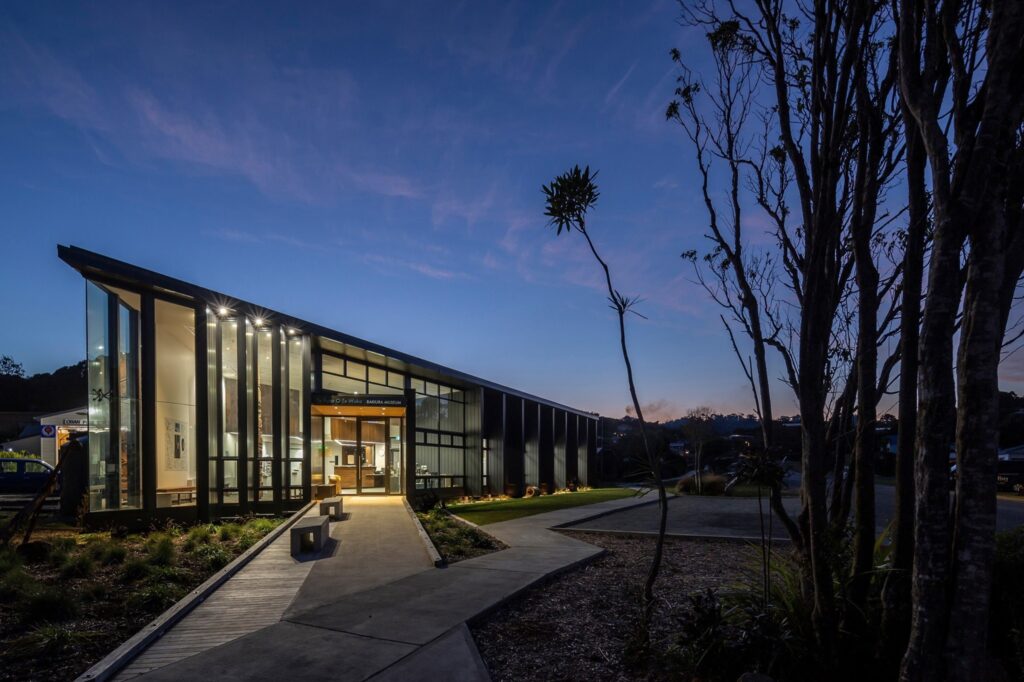
A year on from when they first broke ground, the Rakiura heritage centre was finished on time and on budget.
The new Rakiura Museum
Drawing on Experience
Having worked on the Community Centre, Margaret was able to bring learnings from that project into the Rakiura heritage centre. At the top of this list was the importance of having a vision and knowing that with hard work, commitment and persistence – anything is possible.
As there often is with many large community projects, the Heritage Trust encountered their share of naysayers. A few permanent residents did not see the need for what they only saw as a tourist attraction and felt that the build was a waste of time and money. Rather than stop the project however, these negative comments made the Trust more determined to make it happen.
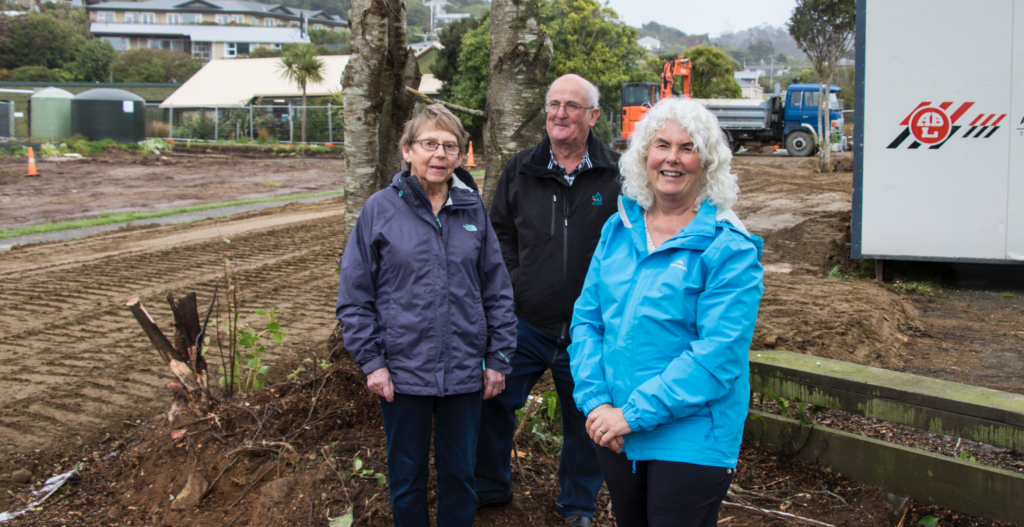
“To us, it felt justified, we know how important our history is for not only Southern New Zealand but for the whole country”
Trustees Anita Geeson, Bruce Ford & Margaret Hopkins at new museum site.
Having a good team with multiple skills and connections was also crucial. The important process of tendering for architects and building companies was done with care, ensuring that the professionals they engaged with understood how important the building would be when it came to representing the community and the history of the island.
Telling the Right Stories
Setting up the exhibition itself was a big step in getting the centre open and one that held many lessons for the Trust. This was one area where Margaret saw an increase in community members who were enthusiastic about getting involved. This provided an opportunity for many locals to see, touch and learn about the items that made up the fabric of their history.
“It gave locals a sense of ownership, especially when they could see their own stories being told.’
It was essential to the Trust that the right voices were heard when it came to telling the history of Māori settlement and habitation on Rakiura. For this, a local iwi committee was set up and engaged with to ensure that the items and stories they had on display correctly told this part of the Island’s history.
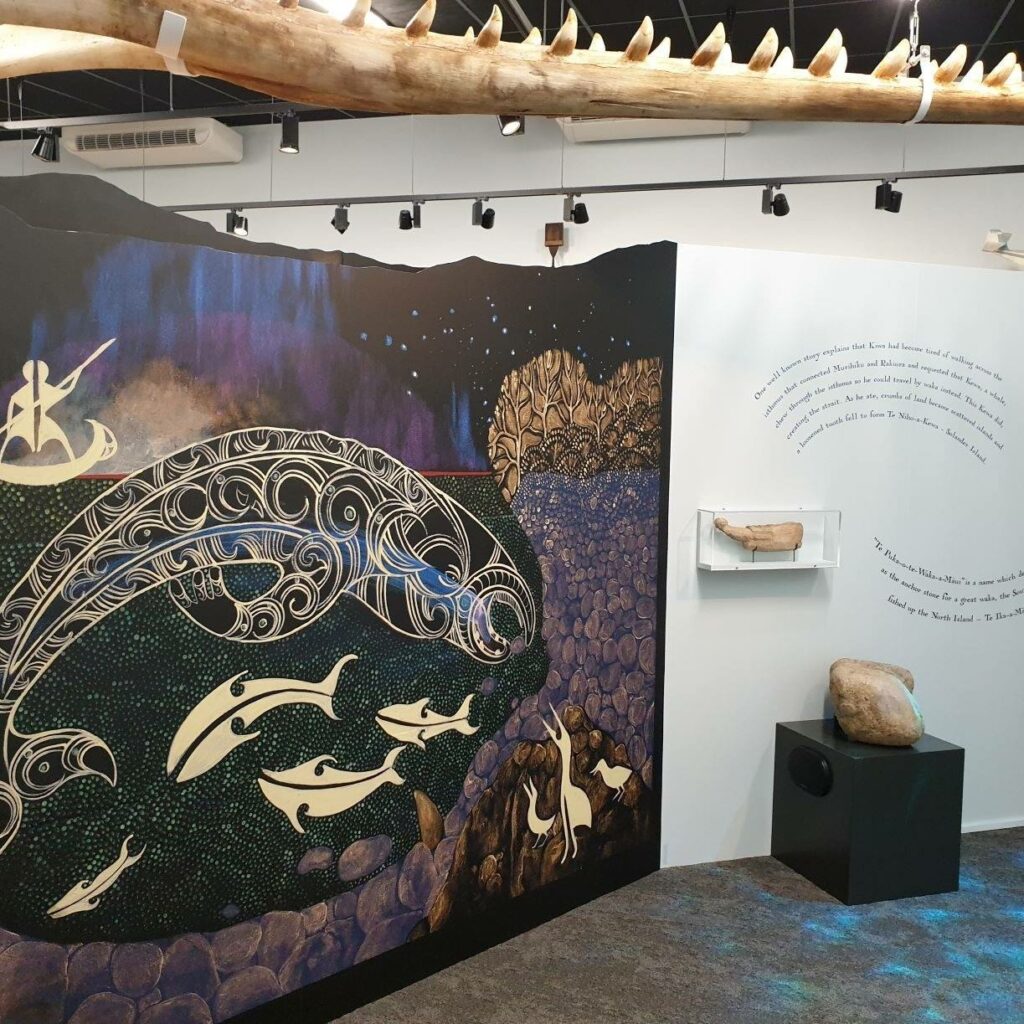
Margaret believes the exhibition is now more balanced because they have the correct stories, are able to focus on what brought people to Rakiura in the first place, and can celebrate the early communities who made Rakiura home.
Exhibition at the new Rakiura Museum.
The Importance of Mana
Despite the Island having a long history of Māori settlement, the culture and stories of local iwi were generally not well known or embraced. However, when the new Rakiura Museum finally opened with a pōwhiri, Gwen Neave who serves on the Toi Rakiura Arts Trust committee which commissioned and supported the Oral History project featured in the Museum, noted that it was a beautiful bridging moment for the community.
The pōwhiri was performed by a group, of which Gwen was a part of, that also included the local school and its students. While it was challenging to bring together and involved weeks of practice, Gwen saw the pōwhiri it as an opportunity to introduce this key cultural element at the perfect time.
‘It brought mana and gravitas to the occasion. It was moving for many there and well-received by those who witnessed it.’
A resident of Rakiura for 55 years, Gwen says the pōwhiri has had far-reaching effects on the island. Te Reo is now being taught to a class where they learn tikanga as well as the history of the island and about the mana whenua who live there. It is also being embraced in places like the local Four Square and in the school where Te Reo and English are used interchangeably.
There is a new dynamic to the community now, one that is more actively embracing biculturalism, the language and the deeper stories of this place. Gwen also notes that she’s loving seeing the way New Zealanders more broadly are coming of age with Te Reo and is so proud of the way that this small community at the bottom of the south is embracing this too.
Community Development is not always a linear path
As it is with any large-scale community project, challenges are always present. Whether it is the practical logistics of building in a remote location or negative comments from some quarters, there will undoubtedly be obstacles to overcome. Creating things for and in the community can at times be messy – it’s never a linear path.
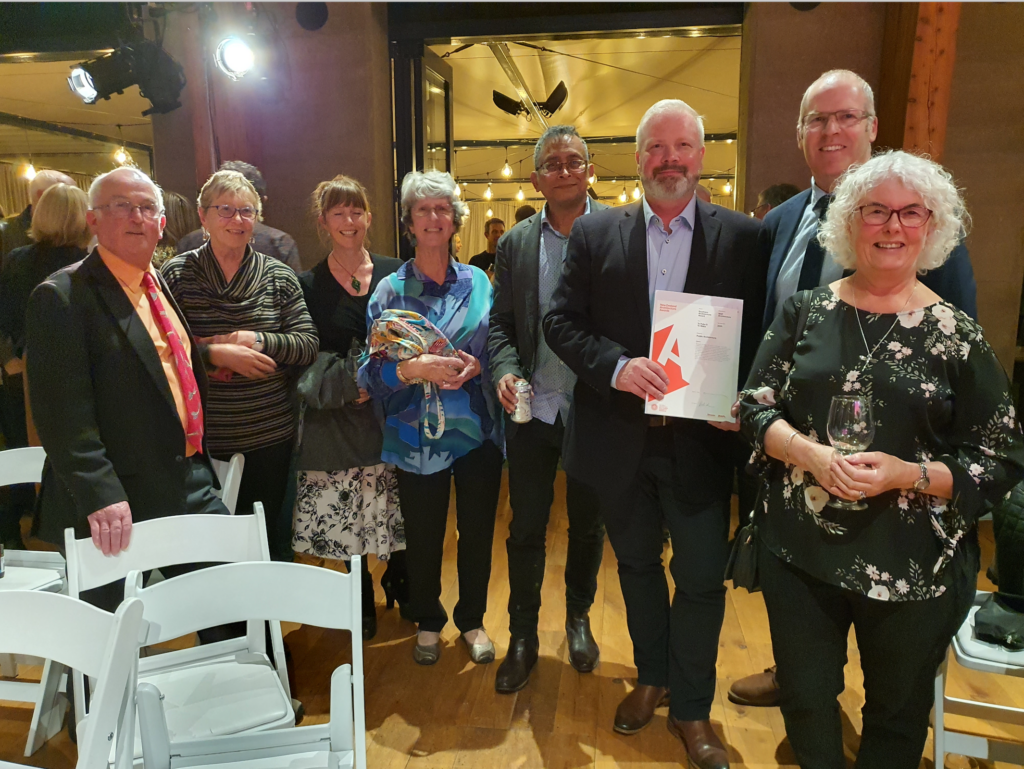
Having not yet been open for a year, the heritage centre has already seen 14,000 visitors through the door. The centre has seen 25 school groups visit as well as strong support from both local and national visitors. To the community it is not only a source of pride and achievement but also a great drawcard to the Island, helping to bolster tourist numbers and support the economy of Rakiura.
Bruce Ford, Raylene Waddell, Jo Learmonth, Elaine Hamilton, Raja Hidzir, Julian O’Sullivan, Ian Sutherland, Margaret Hopkins
Margaret is also excited by the next generation of strong community-led leadership that’s emerging on Rakiura via Future Rakiura – a group formed in 2019 to encourage and build collaborative leadership skills amongst young people. As a mentor for this group herself, Margaret has seen them pull together and lead Waitangi Day celebrations, community get-togethers, and fundraisers for small community projects. Gwen also is a mentor for Future Rakira. Connections help to bind the community together, allowing them to create a unified focus when it comes to getting things done for the people who live there.
“When you come out the other end of a project like this, you realise that no matter where you live, or what resources you have at hand, if you have the vision and the drive to get it done – anything is possible”
I Love Avondale – A story of community spirit
Despite that diversity and a steadily rising population, Avondale experiences some of the highest levels of social deprivation in the Auckland region. This can mean a disconnect within the community, a lack of identity and low interaction amongst its residents.
Dayne Smith has lived in Avondale most of his life and saw an opportunity to put his experience studying and working with the media to use, by celebrating and showing his neighbourhood in a positive light.
I Love Avondale was launched in 2014 – a Facebook and Instagram page used to encourage local pride and community building. Within a short amount of time, it established a strong and engaged virtual community, using the platform to celebrate Avondale, its stories and its people.
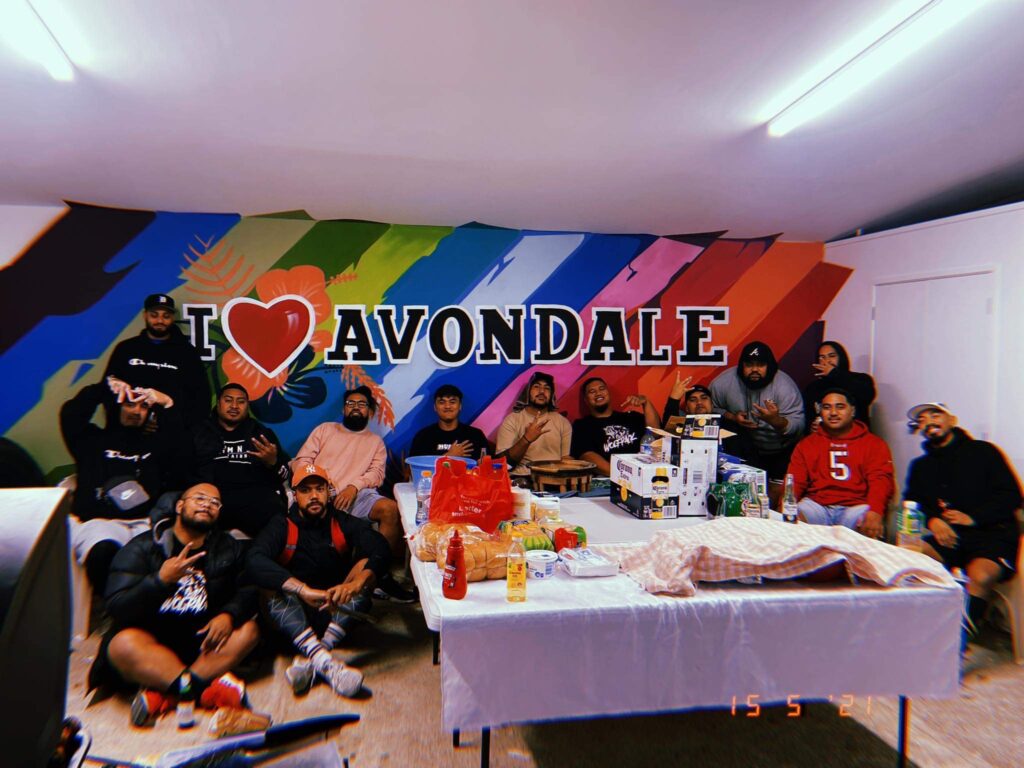
Their community outcomes are now delivered via four interwoven strands of mahi: Kai Avondale community food projects, Eastdale Hub for recreation and youth activities, Storytelling online and on the ground, and Whanaungatanga – connecting, collaborating and advocating with and for others.
Dayne describes it simply as a community development project, but to him and the people it serves, it’s so much more than that. What had started out as a social media page, quickly grew into a wider grassroots community-led project and in 2017, Avondale Community Action brought Dayne onboard as one of two community activators, involved specifically with connections and communication on the ground. Today, I Love Avondale has around 10,000 followers online and over the years, hundreds of individuals, businesses and organisations have contributed to the mahi they do.
Through the I Love Avondale movement and now under the Kai Avondale banner, the community of Avondale have launched initiatives like ‘Feed the Streets’: a free community dinner where anyone is welcome; ‘Free Guys’, a social-style of supermarket where you “take what you need, pay what you can”; and a network of Breakfast Clubs across Avondale. These initiatives are as much about providing opportunities for people to socialise and share each other’s company, as they are helping improve access to food for those doing it tough and reducing still edible food going to landfill.
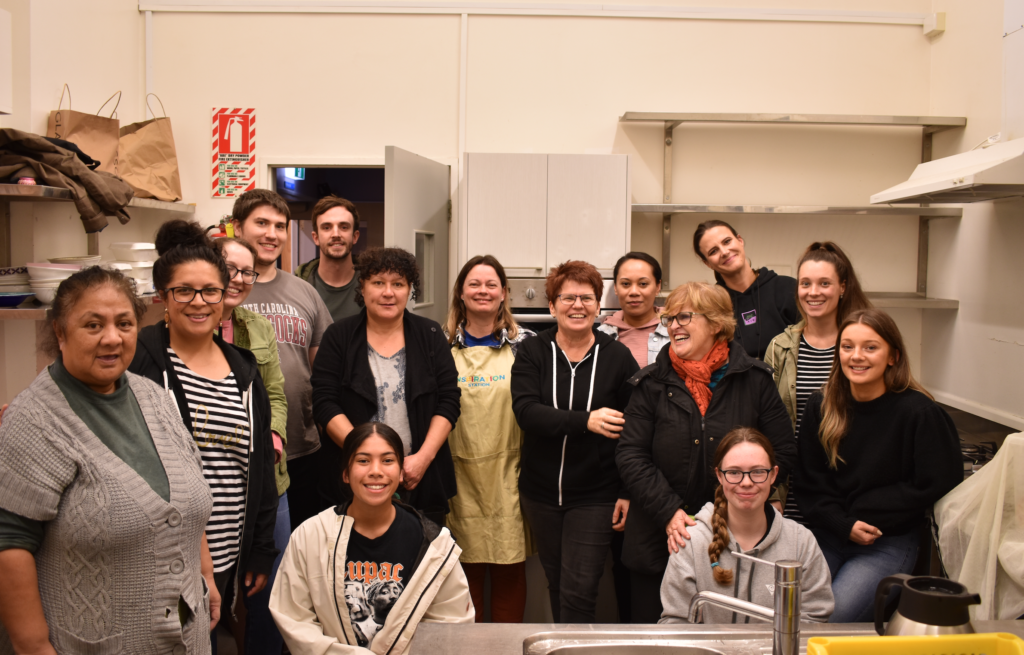
While this may seem like a lot, it barely scratches the surface of the mahi that goes on behind the scenes. Dayne and the team ensure that the connections that might not otherwise exist, are put in place.
Through a connection at Glenavon School, Dayne was able to connect Upside Youth Mentoring with a Ministry of Education-funded opportunity he developed alongside local Resource Teachers: Learning & Behaviour (RTLBs). As a result of Upside coming onboard, the Te Whau Hapori one-to-one mentoring programme was established and now exists in five Avondale area schools, helping 25 students in the first cohort reach their potential through mentorship.
“The Upside programme already existed, we just helped create a new opportunity working with a cluster of schools within a single community. When we identify opportunities, we try find someone who has the skills and knowledge to deliver it rather than reinvent the wheel.”
These connections also extend to the local government. The team helped form a collaboration between Panuku, the Auckland Council’s Development arm, and Crescendo, a music mentoring programme. When Crescendo needed a space to set up a new studio, Dayne approached Panuku, knowing they had empty buildings in Avondale and linked the two together. Now, thanks to this connection, a recording studio exists with a radio station, and even a podcast being produced from its new premises.
Inspired by the ‘Humans of New York’ project which began in 2010, Dayne started capturing the people of Avondale in the same way; by taking their photo and telling their story via #PeopleofAvondale.
This proved to be incredibly popular online and caught the attention of Panuku who managed a large chain link fence in the centre of town as part of the development. This fence had multiple A0 sized frames attached to it for advertising purposes but by working with I Love Avondale, they were turned into an outside gallery space, printing and framing images of the Avondale community. Now an ongoing project, Dayne coordinates the development of new content, curating new images every month. It’s vital that either the creator or the content is from the community.
“My intention is to celebrate the culture, the characters, the place that we live in and showcase it in various ways. There has to be a strong local flavour to it.”

The current images exhibited show children illustrated in the careers they aspire to have – a project that brought an illustrator will local connections and a school together and one that the community is particularly proud of.
For Dayne, each day within his community is an opportunity to learn about what they need. He stresses the importance of coming into the community, not to tell them what they should be doing but instead, listening, observing and learning from those around him.
“We have our arms around our community and we are doing it together.”
Based on their experiences over the last seven years, I Love Avondale offer up the following advice to those considering kicking off something similar in their community.
“Really think about what you want to achieve. Are you trying to do something with a community or to a community? If it’s the former – and it should be – you need to connect with locals and do it on their terms. Constantly listen and observe, and use what you learn to shape your responses. Let the feedback and energy from the community inform your decisions.”
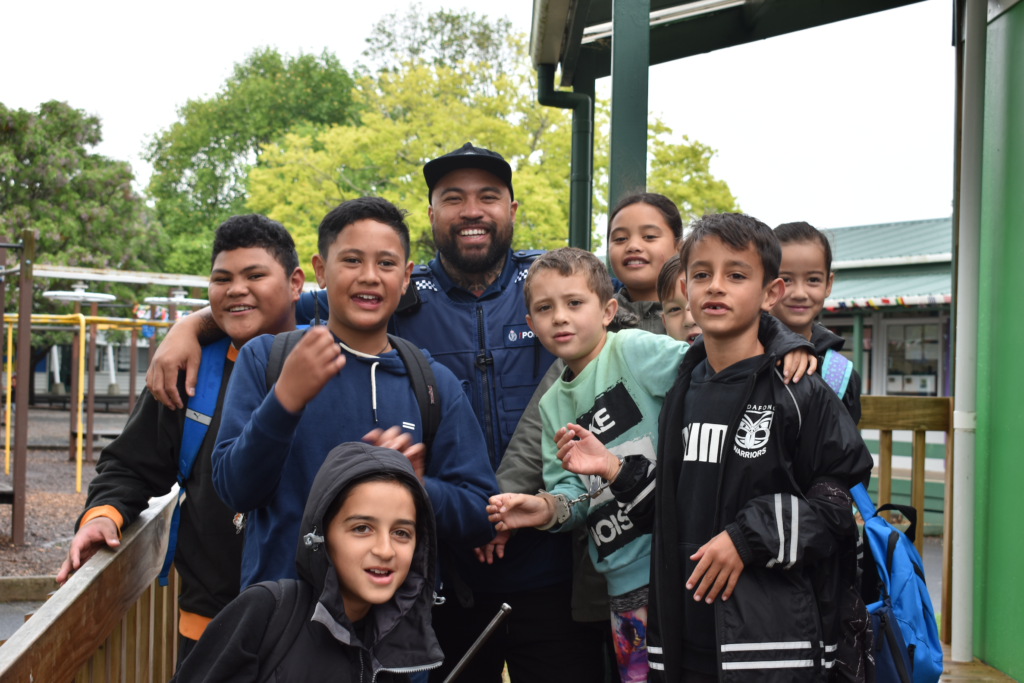
While I Love Avondale still maintains storytelling as an integral part of its existence, it has undoubtedly gone above and beyond its initial vision from 2014 – Collaboration, advocacy, connection and engagement continue to drive the community to ensure that I Love Avondale is not just a name of social media pages, but the collective feeling of the community.
Thriving in the unlikeliest of locations: Waimamaku’s Story
When the factory shut down in the 70’s, hundreds of locals lost their jobs. With no other major employment opportunities, the town experienced a steep financial decline. Although over 40 years ago, the closing of the factory highlighted just how tenuous the employment situation in remote rural towns can be and how vital local support is when it comes to revitalising a community.
Waimamaku is home to all of 500 odd residents, and within the walls of the old cheese fridge, they are able to find a source of social cohesion. A place where locals can meet, get to know one another, discuss what they feel their community needs, and learn new skills.
From the most humble of places, locals receive computer-related assistance, get help with funding and admin issues, enrol in workshops, and share skills that have been identified as important to the community. Educational opportunities are always present, along with after school activities and resource centre volunteers who take people to town to run errands once a month.
“We provide workshops to enhance skills so that people here are given a pathway to employment. For example, we have workshops such as ‘Potions and Lotions’ for locals who are interested in getting into cottage industries. They can make their own soaps and then sell them at the monthly market alongside other local products and produce.” COURTNEY, PROJECT COORDINATOR, WEKAWEKA VALLEY COMMUNITY TRUST.
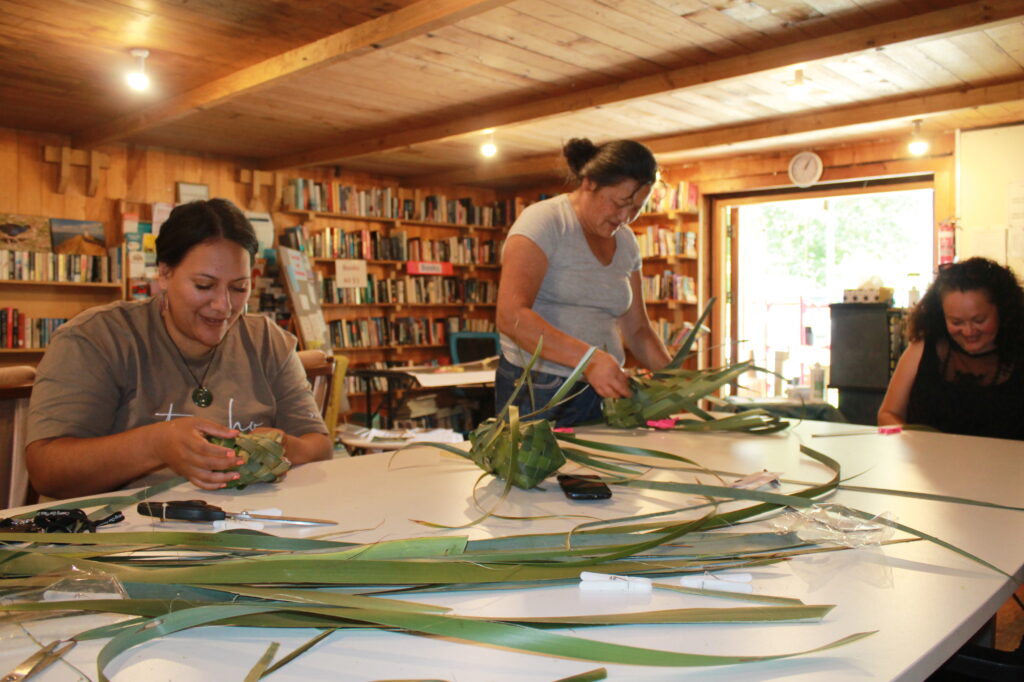
“We had a number of community meetings where we used paper and pens and mapped out our collective vision for Waimamaku.”
Grow from shared local visions
The Waimamaku community are working toward a strong collective vision for their home. The community got together to decide what they felt Waimamaku needed. Collectively, they mapped out their vision and made an application to the Department of Internal Affairs’ Community-led Development Programme. A partnership with the DIA has brought funding to focus on the needs and aspirations of the community, as well as the supporting the operating costs of the resource centre.
Build from strengths
Due to its distance from other main centres in Aotearoa, their place continues to face limited job opportunities, a lack of options to train and upskill, and a shortage in public transport services. But locals feel many of these issues can be addressed through connection and collaboration. Meetings, dinners and get-togethers are set up to help locals share their own aspirations for their community. The community understands that if they are all on the same page, they are able to harness this power as a collective group to make change for the better.
Without the shared skills of the Waimamaku community, the centre may not have had such a strong revival. The centre draws on these strengths, fostering environments in which people can learn from their neighbours. A recent example is when a community member came to the centre to discuss the expenses of installing a new septic tank. This led to the centre engaging with a local who agreed to run a workshop, teaching people how to build their own composting toilet.
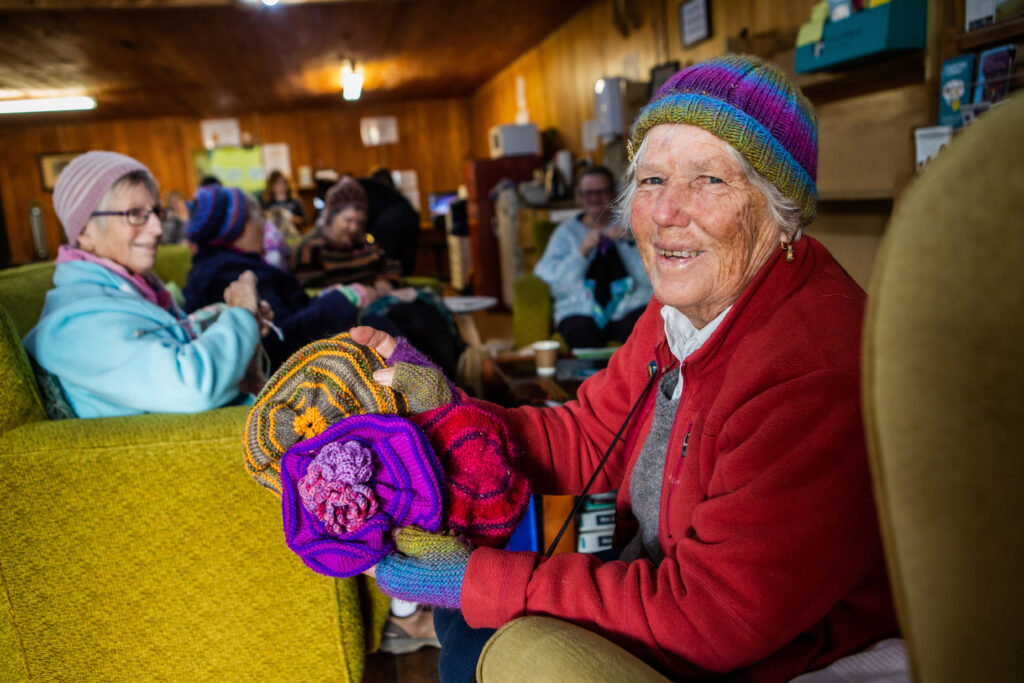
“In Waimamaku there are many different individuals with amazing skills and knowledge. Here at the Resource Centre, we can be the connector for these individuals.”
Work with diverse people and sectors
The Wekaweka Valley Community Trust also supports a number of other unincorporated groups in the valley by assisting them and holding their funds. For example, the community garden group can apply for funding under the trust as well as a social sports club and a health initiative. All ideas and groups are welcome with locals recently setting up a soft plastics recycling, a pataka kai food pantry and a seed swap.
Learn by doing
When it comes to community-led development, you can try to plan ahead as much as you like, but there is no blueprint for things like this. Each community is different with varying needs.
“There is a bit of a strategic plan within the centre but a lot of the mahi is done by people getting together and simply just doing it. There doesn’t have to be too much overthinking. All you need is a few passionate people who come up with an idea, draw the community around them, and get things happening organically.”
Looking ahead, there will be more educational opportunities within the centre on the horizon. At the moment they are working with NorthTec, a tertiary provider in northern Aotearoa, to bring computer classes to the community. And as invaluable as their humble meeting place has been, they would love a new, larger facility for their growing needs. Something that the centre and their community are working towards, together.
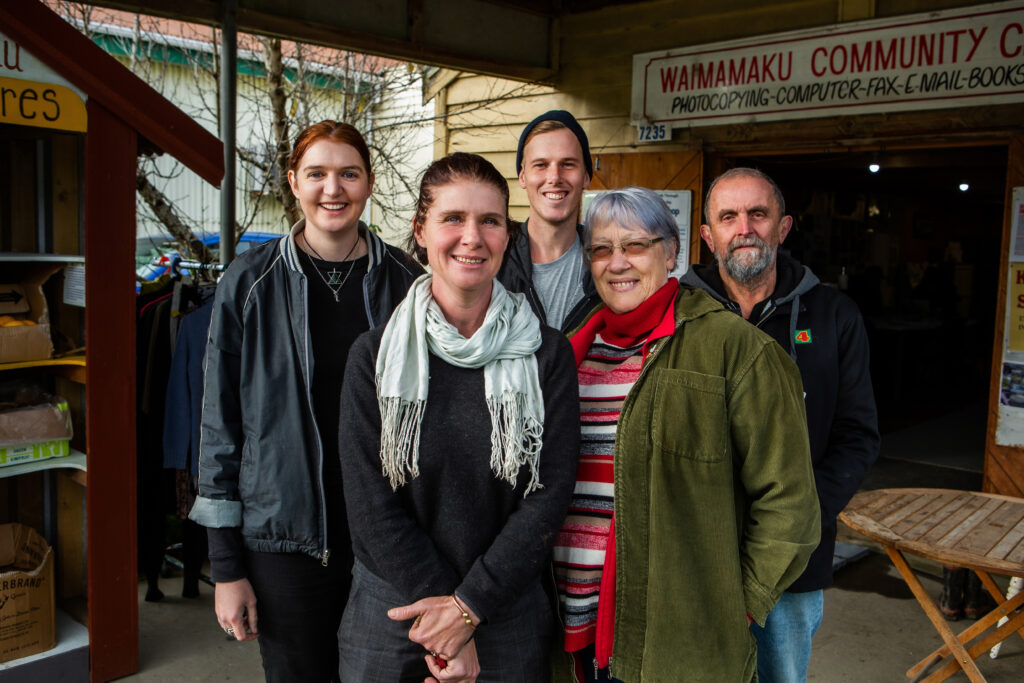
The floors may be a little uneven, the walls lacking windows and there are a few leaks here and there but it is the community-led mahi that happens within the old cheese fridge that matters, proving that it’s not the place but the people around you that give the community heart.
Facebook: @WaimamakuResourceCentre
Joy for Generations: Nurturing intergenerational connections
As the old proverb goes, it takes a village to raise a child. Having strong relationships and connections with people nearby who are young and old, contributes to children, young people and parents’ sense of belonging and safety. And this feeling goes both ways – all generations benefit from feeling connected with their community.
For those of us with our heart in transformational initiatives, Joy for Generations (JFG) is a story of building connections in local communities to bridge the gap between generations young and old. It’s about learning from one another, proactively counteracting loneliness, and reconnecting community.
Intergenerational connection and learning have always been a fundamental part of flourishing, thriving communities and cultures. Yet too often we divide our communities and activities up by our age.
Our young people are in schools, while more mature and ageing generations often now live in retirement communities or aged-care facilities. As a result, there is often little interaction between generations.
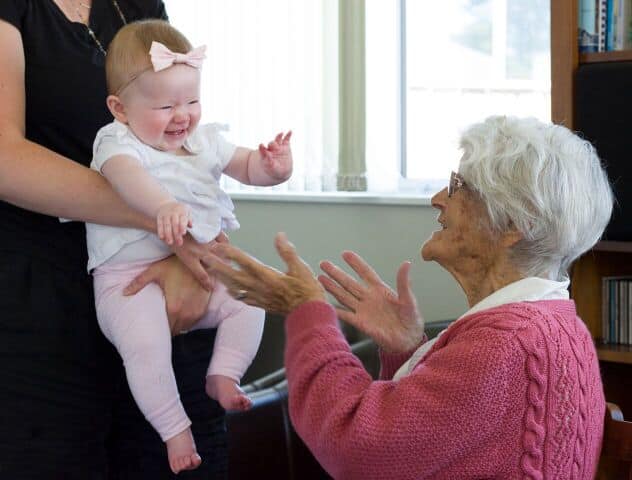
Joy for Generations’ story demonstrates the importance of building intergenerational wellbeing in place, reconnecting our young people with the learnings and love of those before them.
Building a community within a community.
Lucy Adlam is a self-starter. Working for a not-for-profit organisation that connected older people with services in their community, she was about to take maternity leave when she decided to spend two weeks in the call-centre before she left. Her experience there changed her.
“Some of the elderly people I spoke to said it was the first phone call they had received in months.”
Lucy decided that once her daughter was born, she’d start volunteering and spend time with seniors – knowing firsthand how important it is to involve everyone in community activities, to relieve isolation and improve their wellbeing.
Lucy began visiting rest homes. She remembers the memory of seeing people with no visitors, month in, month out.
“I still feel it all over my body.”
One day, Lucy noticed a woman lying still in her bed, unmoving. It wasn’t the first time she had noticed her. Not knowing what else to do, she carefully knocked and poked her head around the doorframe.
“Hello… there’s a baby here!”
The woman immediately rose up. She managed to climb out of bed, and she began to sing to make the baby laugh. It was as meaningful to Lucy as it was to her young daughter – with the older lady now dancing around the room.
This was the moment that the seed for Joy for Generations was planted.
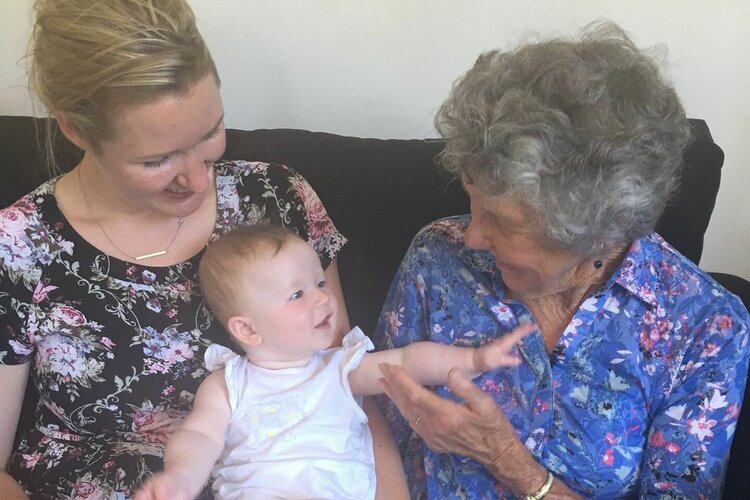
Connection is essential to wellbeing.
Weaving together the strengths and relationships in your place.
With a young family, little time, and – at this point – no funding, Lucy knew it was important to first build from her own networks, relationships and local strengths. She began to engage the other new mothers within her antenatal groups.
Lucy began bringing more new mums to visit with the rest home, and they created intergenerational playgroups.
This point on their journey was about building relational capacity, and growing the group’s momentum through a sense of fulfilment. JFG wasn’t yet official, but Lucy’s connections within the community were growing.
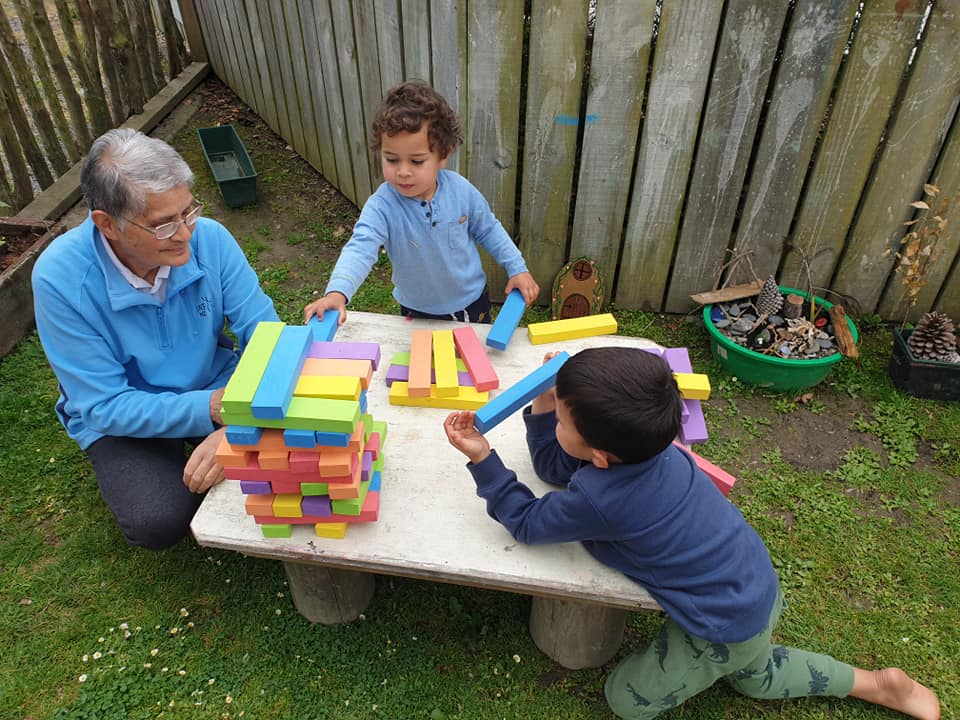
Intergenerational play brings fun and connection to all involved.
Leaning in, and learning as you go.
Joy for Generations became official when Lucy moved to the Wairarapa.
By working to identify their kaupapa and vision of intergenerational wellbeing, Lucy was always learning.
“As much as we loved to see the playgroups grow, we noticed an imbalance of attendees, with rest homes having large groups of seniors and children feeling a little intimidated. This helped us to see that a core value in our groups was equal enjoyment for all generations.“
On the back of this learning, the group learnt to adapt their vision by focusing on how to bring the different generations together in a way that benefited the joy and learning for both generations.
JFG began teaching children more about older generations to make them feel more comfortable and increase their understanding of other generations. This helped children understand the meaning behind the intergenerational activities.
One of the most important parts of mindful development is to recognise that it’s easy to get busy with the ‘doing’, and not make time to reflect on what’s working, what’s not, and how to adapt.
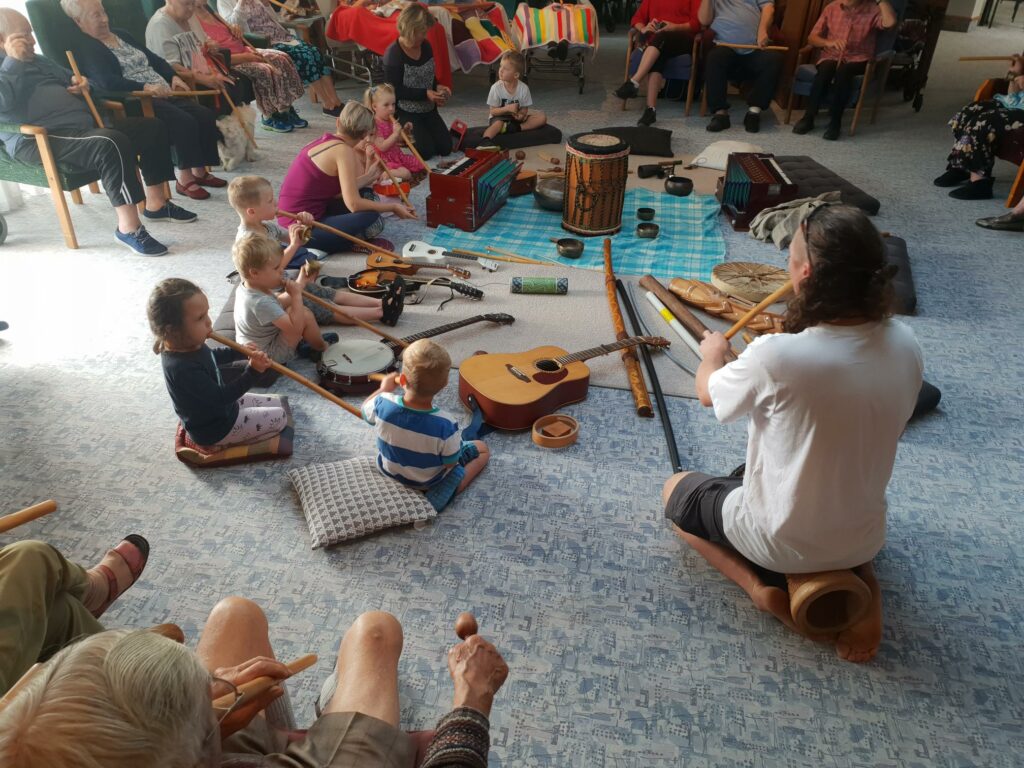
Music workshop for the young and the young at heart.
Building momentum through collaboration and experiences.
Collaborating with diverse community groups and organisations Age Concern, Ka Pai Carterton and Neighbourhood Support, and connecting with the three district Councils in the region, JFG formalised their structure and set up a Board of Trustees to provide strategic guidance.
JFG organised a community hui (Wairarapa Children’s Day) and invited local kaumatua to share stories and crafts with children. Strengthening connections and relationships with local iwi was always a priority of this kaupapa.
“Maybe because it’s a small region, there is a strong sense of place and belonging here. Everyone just got involved. We only initiated the start and it grew into this wonderful thing.”
Poi workshops were held at the local primary school, and several rest homes brought residents to the school to participate. The only challenge was getting the seniors back to their rest home.
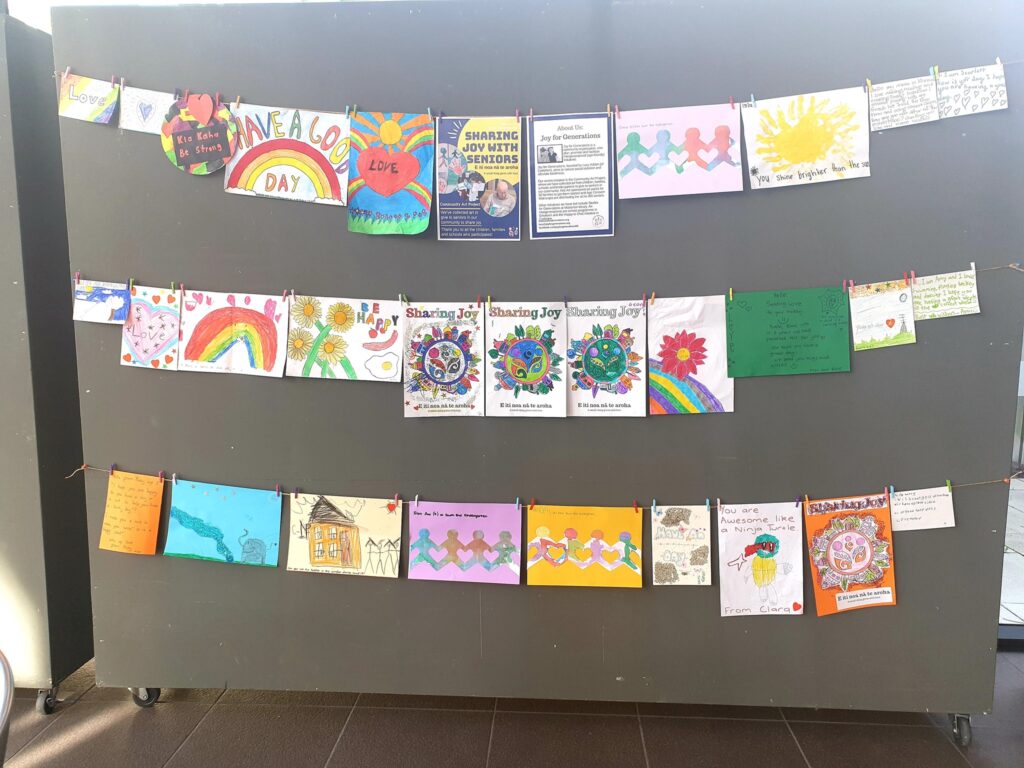
Sharing Joy” artworks created by local tamariki.
During Lockdown, JFG acquired some funding to create art packs for 50 families, sending the art out in collaboration with Age Concern.
“One older lady called me and told me just how much the artwork blew her away. She didn’t have any family or grandchildren around her. The young boy who created the artwork now calls that lovely lady his ‘NZ Grandmother’ – and they exchange art work and cards regularly. I mean, that is just one of those wonderful moments.”
A rally cry for more diverse funding models.
As JFG grew, so did its financial needs. In what is a familiar story for many grassroots community-led initiatives, their sustainability and impact rely on volunteers, on funding and in some cases, self-funding. More and more rest homes wanted to set up intergenerational playgroups, but this began taking more resources than JFG had to give.
Building relational capital, nurturing local relationships and developing adequate funding proposals all takes resource, capability and capacity that some locally-led initiatives don’t have to spare.
“As community-led initiatives continue to learn and develop as they go, it calls for funding models and procurement systems to do the same. One system does not fit all.”
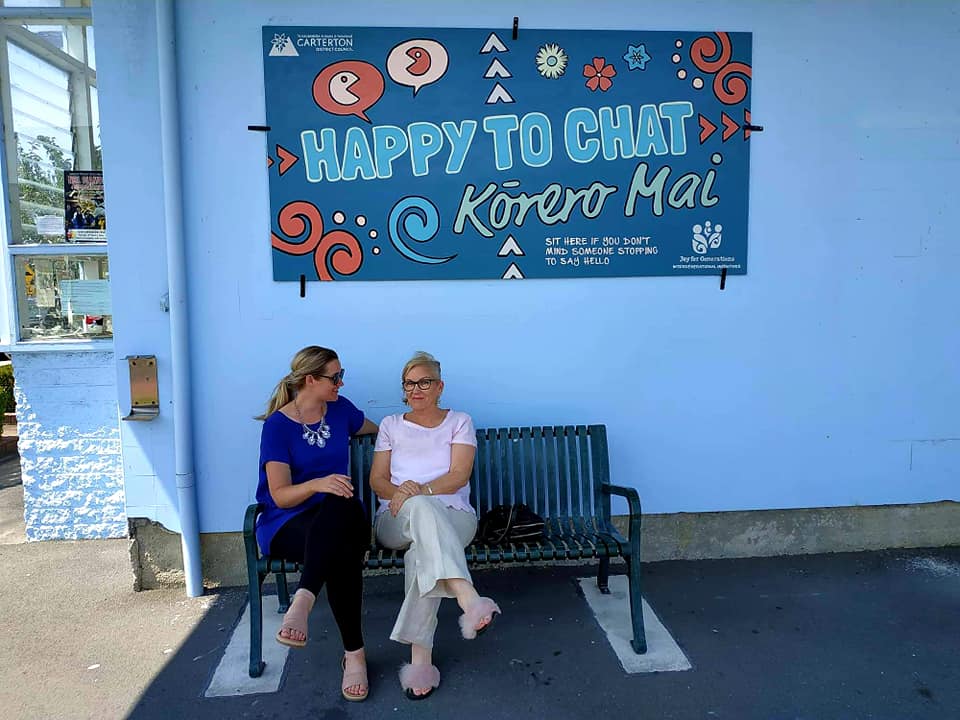
Another JfG initiative, the Happy to Chat bench, invites people to connect and share a yarn.
Funds might run out, but the community never goes away.
Intergenerational practices provide a setting that can help to relieve isolation and involve people in activities that contribute to – and improve – the general health and wellbeing of our societies and of our families.
The relationships built, the learnings gathered, and the people who have now been connected and inspired by JFG continue to exist in the Wairarapa.
“There are a couple of other playgroups at rest homes around New Zealand, but no other organisation is focusing on intergenerational initiatives and connections. We’ve really tried to develop the intergenerational space here in New Zealand, and have been found online by groups in America and Asia who have contacted us for support. Some things work out, and others don’t. It’s all learning. People who want to better our communities, our tamariki, our elderly, will never go away.”
Lucy is pragmatic. She sees JFG as a pilot, and hopes that it will be an initiative that sprouts again inside and outside of the Wairarapa region, fostering age-inclusive communities all across Aotearoa.
If you’re keep to tap into Lucy’s experience and ideas on building intergenerational connections, you can contact her at lucy@joyforgenerations.org or through the website www.joyforgenerations.org.
Video: The Heathcote Village Project
10 years on from the tragic earthquakes that struck the Canterbury region, The Heathcote Village Project share their story from the epicentre of the quake, with a focus on the power of community when working from a strengths-based model.
“It’s that shift that is happening at a world-wide level of realising that we are living. Therefore we need to think in more of a living systems way. A dynamic way that allows for emergence and doesn’t go pre-prepared.”
Kidshub: Looking after our tamariki, whānau and community the CLD way.
Over the last two years the Christchurch Methodist Mission (CMM) Community Development team have worked alongside a group of whānau who are passionate about providing experiences and opportunities for their community. Together they have created the ‘Kidshub’ initiative in Linwood, Christchurch.
The Kidshub committee is now made up of 5 whānau leads and committed to providing low cost or no cost activities for whānau in the Linwood area. Building on the seed of an idea sown at a parents’ hui about five years ago, they have been busy organising community meetings and community events for their whānau, tamariki and the wider community.
With support from a CMM Development worker, a family worker from the Linwood Community Corner Trust, a Christchurch City Council advisor and Kim from the STEAM collective, the committee has organised a range of activities for the community during the school holidays. These activities all promote brain development and team building: they include art and craft, high tech days, maths exercises (using dragon cards in order to complete mathematical tasks in a fun way), engineering exercises, as well as bus trips to Victoria Park, Willow Bank and Spencer Park. Moreover, the committee also organised several community events throughout the year such as a kids market, Quiz night, neighbourhood BBQ, pizza nights and a light dance.
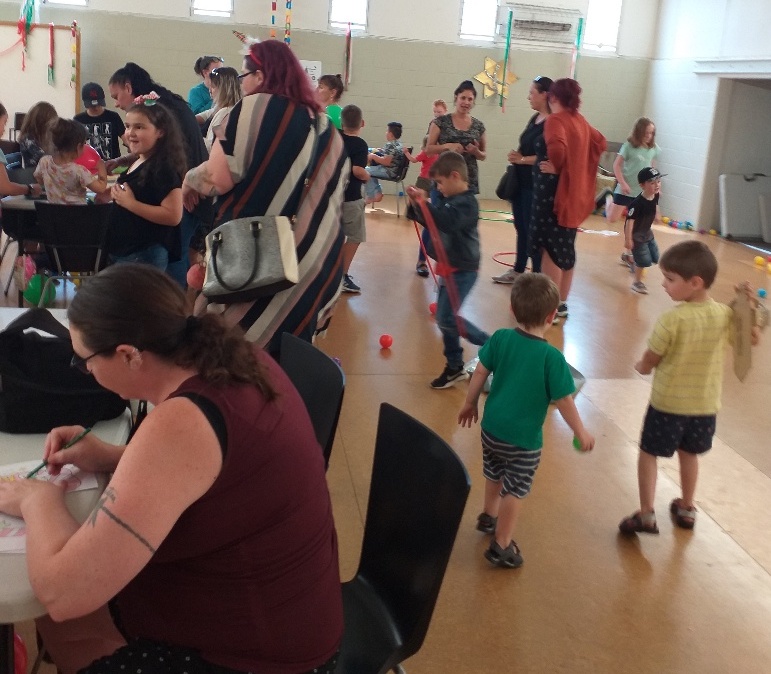
Fun for everyone at the Kidshub Activity Day 2019.
In February 2020, whānau and tamariki presented Kidshub to the Linwood Community Board, sharing their vision and goals: to give the tamariki the kind of experiences that they have been dreaming of, experiences that they wouldn’t normally have access to, and to enable whānau to share these experiences with their tamariki. The Kidshub committee envisions these experiences to come at little to no cost for whānau to ensure that tamariki have the highest possible likelihood of being able to participate.
Kidshub is all about fostering community connections in a neutral environment. A place to nurture whānau connections and to create a sense of belonging and bonding, with shared interactions and new experiences in a safe space for whānau to enjoy time together.
“We value the whānau being present at Kidshub so that these memories can be experienced and reminisced about together.”
Abbi, Kidshub parent leader
Key community-led learning from Kidshub:
In talking with the committee whānau about why they enjoy the Kidshub, they speak about the relationships they been able to build with the people whom they have met, and about having grown in confidence. The hope is that this will filter through to their tamariki to grow more confident and eventually become leaders in their local community. Kidshub is nurturing this growth and providing opportunities for leaders to grow.
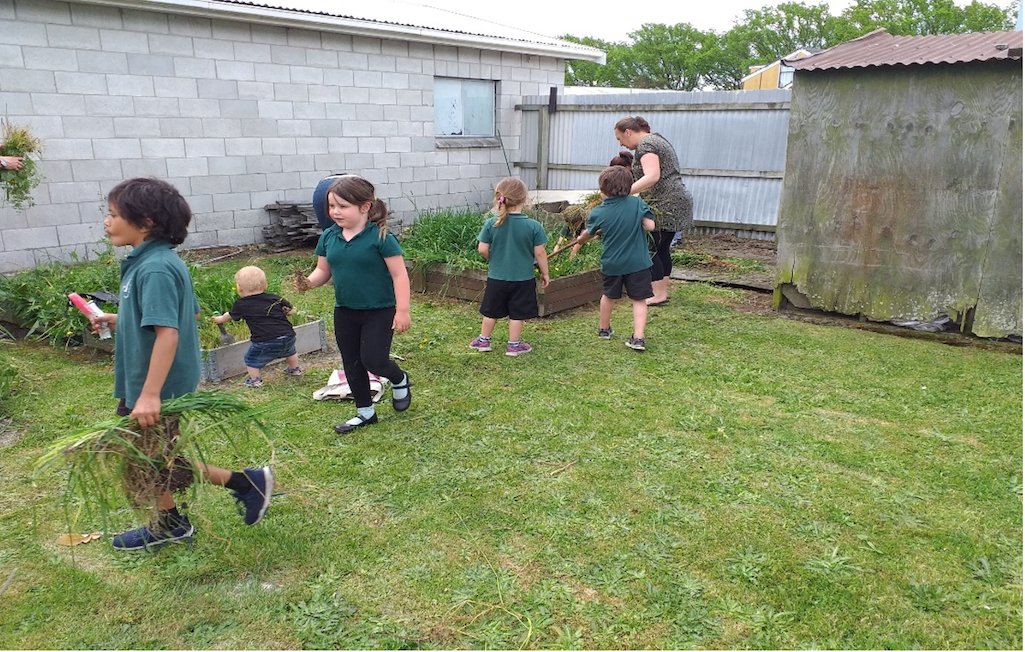
Gardening is a great way to learn for the tamariki.
The success of the Kidshub initiative points to the role that the following key principles of community-led development play in community projects:
The importance of place and a sense of belonging
There is a long term commitment to the mahi because the whānau feel a strong sense of connection to, and ownership of the places and spaces occupied. Working in collaboration with the neighbourhood and making sure everyone felt safe and respected, the committee cleaned up the section, removed rubbish, and turned it into a space that was safe and safe for everyone to enjoy.

Belonging, community and play are represented in the Kidshub logo.
Taking the time to listen and understand local voices
“We listened, opened up possibilities, we took our time because we didn’t know what would happen.”
Anne Gibling, CMM Community Development Worker
The committee dedicated a lot of time to building trusting relationships with the whanau in their community, and involved them in every step of the process, starting from scratch and finding resources needed to create a space where everyone felt heard, understood and had their needs met. It is from the shared experience and active listening and engagement that trust, respect and relationships can grow.
“The way we talk about others is important in shaping how we connect.”
Anne Gibling
Local leadership and learning by doing
The driving power behind Kidshub was the leadership of the four key women and their wishes for their children. Putting these ideas into action and reaching out for support where they needed it enabled them to build relationships with people in the wider community, even with those whom they never imagined they would be able to connect with. They were able to build trust through making the commitment to show up, listen and act on what they promised. Growing and learning along the way, there is not set-in-stone agenda, the whānau are shaping next steps as they go along – together with their community.
For more information on the Kidshub initiative, please email Anne Gibling, Christchurch Methodist Mission.
Punching above its weight: The revitalisation of Reefton.
Similar to many other small towns across Aotearoa, the people of the West Coast township of Reefton have been working hard to revive their town and restore not just its history but its future as well. In early 2019, key economic indicators demonstrated that what locals had intuitively felt was indeed happening: by March, the GDP in Reefton had grown by 14.6% and its labour market had grown by 14.5%, compared to the national average of 3% and 1.9%.
The decades of work to revive their town’s fortunes were paying off!
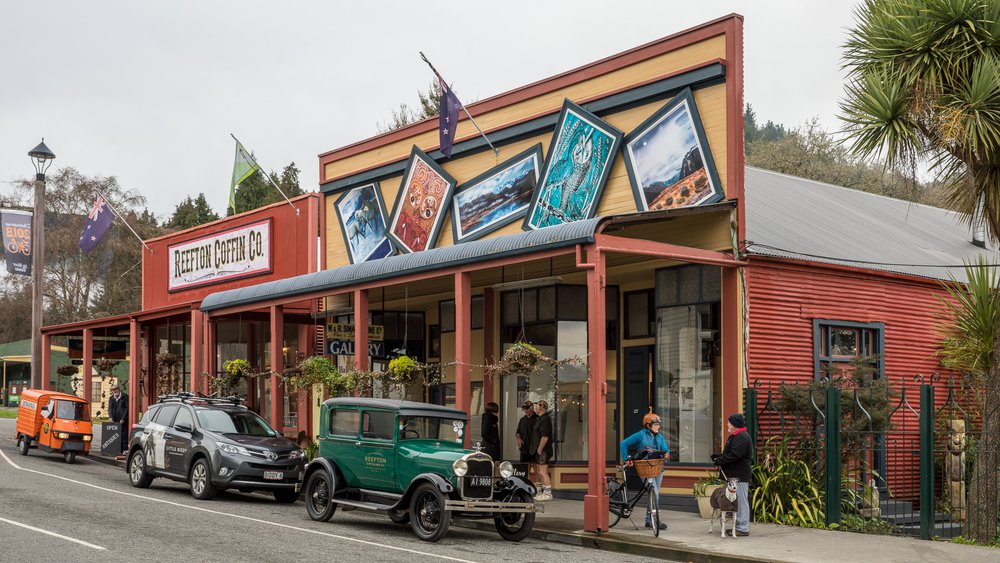
Reefton’s beautifully restored shop fronts on the main street.
A real boomtown during the heydays of hard rock underground gold and subsequent coal mining (with 2,000,000oz of gold extracted between 1870 and 1951!), Reefton, like many small regional towns, went into a significant decline during the last decades of the 20th century, struggling with a changing economy and increased privatisation. The closure of major Government departments such as the New Zealand Forest Service and Railways resulted in a drastic shortage of local work opportunities and consequent rise in unemployment in the area.
But Reefton’s locals are fiercely loyal to their place and have worked together to transform Reefton not only into a popular tourist destination, but also attractive to entrepreneurial investors and new residents seeking a lifestyle change.
Shared local vision grows collaborative local leadership
PAUL THOMAS
“You need catalysts to take communities forward.”
The revitalisation of Reefton into a contemporary, progressive town can be attributed to a mix of external backing and community-led initiatives, as well as the dedication of passionate individuals, who together have produced remarkable outcomes for their town. In his position as manager for the Department of Conservation, Paul Thomas moved to Reefton in 1990 and saw the potential of Reefton’s unique location and history despite its then rather impoverished state. He’s been a hard-working advocate for the town ever since: Paul was part of the first core group of locals pushing for change, seeing an opportunity to leverage Reefton’s unique environment and rich heritage history. Proudly known locally as the “Town of Light”, many people may not realise that the Reefton was actually the first town in the Southern Hemisphere to have a public and reticulated supply of electricity in 1888, even before London and New York!
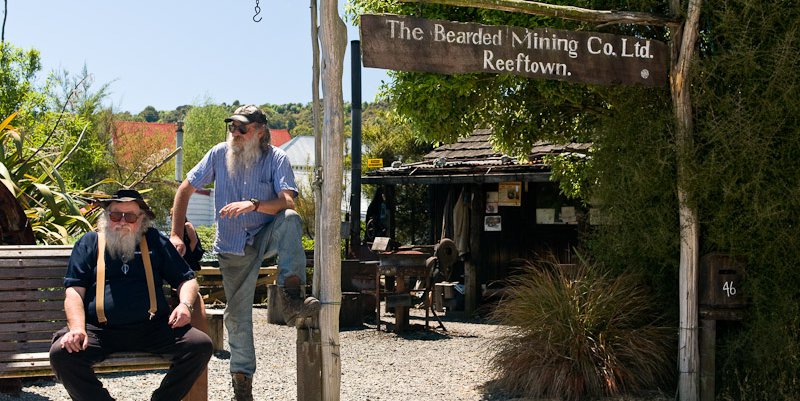
Reefton’s rich heritage is ever present.
“Town revitalisation is an organic process,” says Paul. “You need catalysts to get things going. One of the first catalysts for Reefton was developing a community vision back in 1996.”
Around 90 people came together for the “Community Revival Workshop”, and collectively put together a list of Reefton’s best attributes. This list evolved into the “Reefton Revival Plan” which proposed ways forward to build from the town’s strengths and assets. It was widely distributed within the community in the hope of getting as many people on board as possible.
The Reefton Revival group aimed to revive and celebrate Reefton’s goldfields character from the 1870s. One of the first big initiatives, straight out of the workshop, was to redesign the proposed new addition of a library to the Buller District Council’s service centre – despite significant pushback from the Council and local residents, the group managed to move forward with their vision for the new building to reflect the distinctive heritage look and wooden architecture of Reefton’s original buildings – despite a more modern build.
In 2002 the Reefton ‘Shop Front Project’ focused on further bringing back the distinctive character of the town’s main street. “This project was very innovative and transformational for Reefton,” says Paul. Led by the community’s town promotions organisation, the Inangahua Tourism Promotions (ITP) / Reefton Promotions Group, the Shop Front Project group used concept architectural drawings of Reefton’s main street buildings by local landscape architect Liam Farrell to illustrate how they would look refurbished, and together settled on a heritage colour scheme.
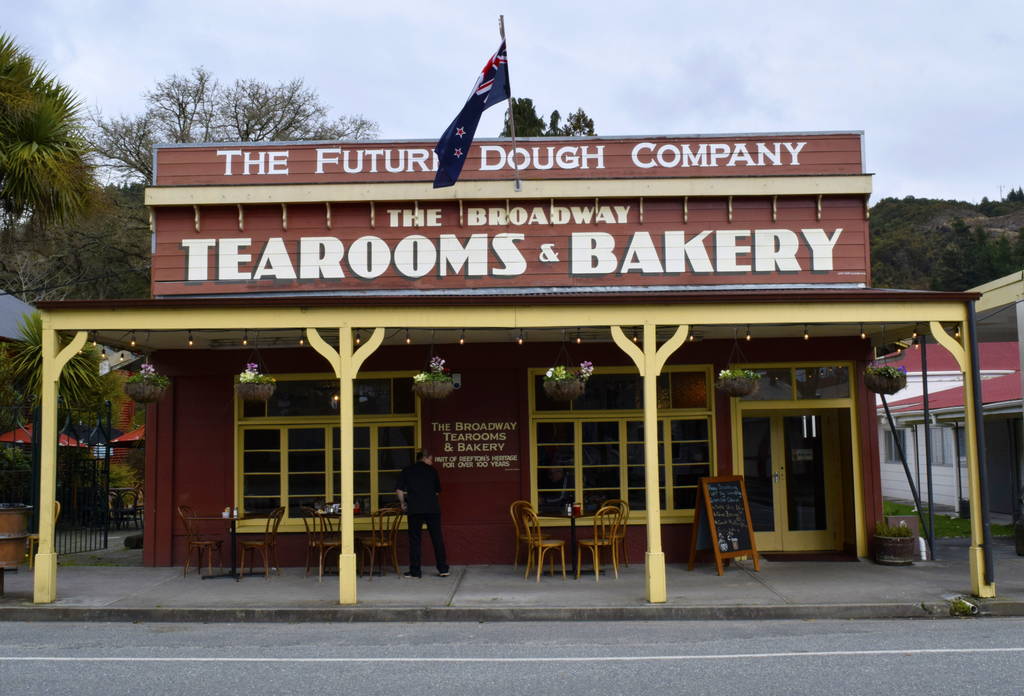
The Reefton Tearooms and Bakery are one of the beautifully restored cafés in town.
With the vision in place, the Group applied for the necessary funds from Development West Coast (DWC) to restore several shop fronts on Reefton’s main street. The ITP / Reefton Promotions Group was responsible for managing the loan received from DWC, and to on-loan the funds to individual business owners to restore their facades. “The project was a significant success story for DWC and it was a transformational project for the town,” reflects Paul. “With each phase of the project, we saw more and more buildings restored, as individual homeowners joined in and applied for finance to also fix and paint their buildings.” The cumulative result over the course of a decade created to a substantial lift in the main street’s appearance, which in turn resulted in a great sense of pride in their place for the locals, and in a new surge of visitors who were captivated by the charm of the place.
More than 20 years on, further restorations of Reefton’s building stay true to this colour palette which has resulted in a vibrant and authentic Reefton town centre filled with busy shops, cafes and art galleries. It is this distinctive look and celebration of Reefton’s heritage that really sets the small town apart from others and is not only a source of pride for the locals, but also underpins the town’s plan to secure long-term economic growth and sustainability. This vision has also attracted new entrepreneurs, investors and visitors alike.
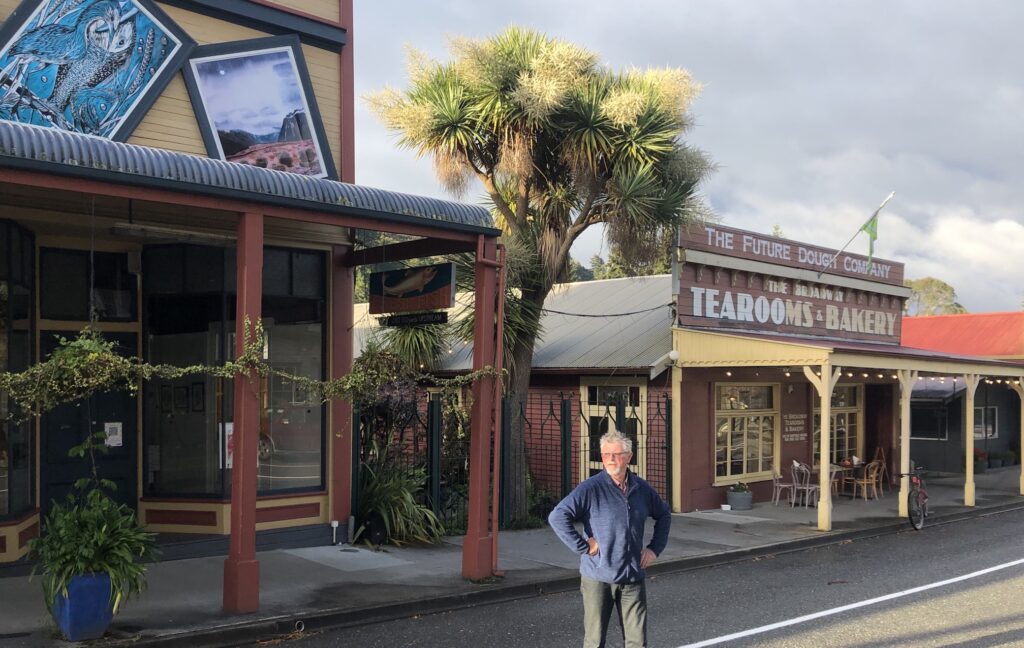
Paul Thomas on Upper Broadway where a significant first phase of the Reefton Shop Front Project took place, including the Hale Gallery on the left.
Drawings for the Reefton Market’s transformation into Hale Gallery.
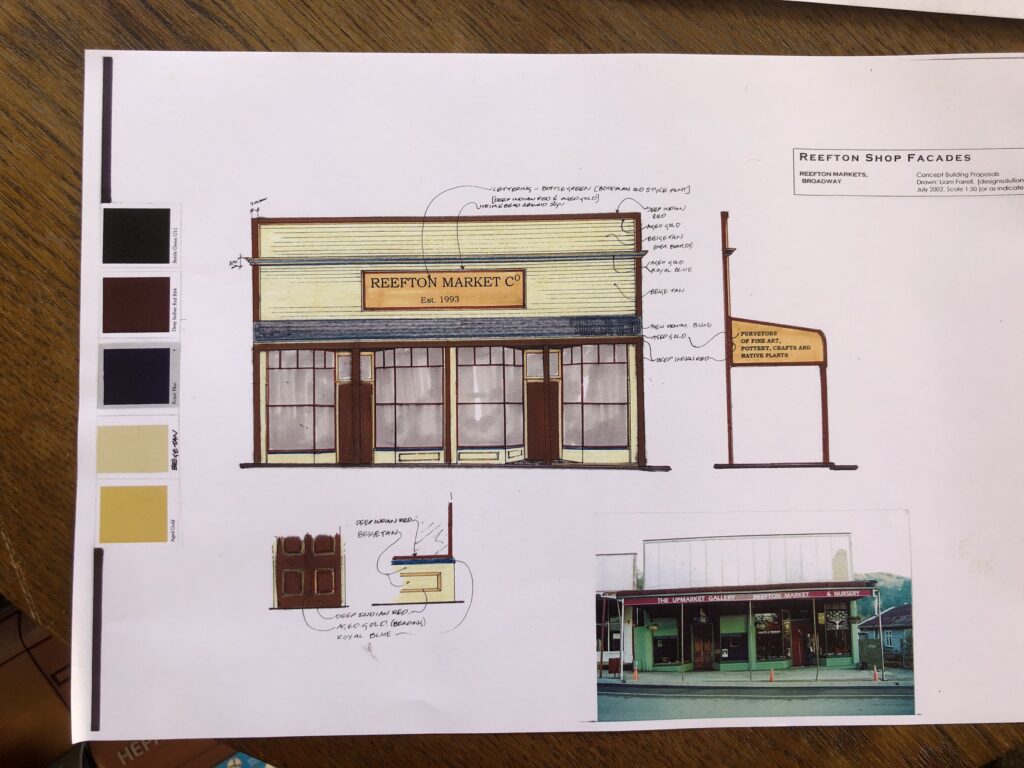
“The investment by DWC into Reefton through the shop front project was an innovative model, a leap of faith at the time for community-led economic development, and it has created immeasurable results that have ensured the town’s long-term sustainability,” Paul says.
Working with diverse groups, ideas and skills
“What has happened with the shop fronts since the early 2000s has been sensational. The face of the town has now changed – now we have a town that we are all very proud of.”
HELEN MCKENZIE
Helen McKenzie grew up in Reefton before moving away in her twenties, and recalls that during her frequent visits back, Reefton was “a busy little town, but things were starting to look a little sad”. Returning home about six years ago, Helen now describes her hometown as being back to its old buzz and attracting new residents with its restored heritage buildings and beautiful surroundings: “People often comment that ‘it’s just like Arrowtown before it got too developed’.”
Helen now manages the local Dawson’s Hotel and reflects that the secret to the town’s resilience lies in its many offerings – unlike other heritage towns, it does not solely rely on tourism. Gold and coal mining remain critically important for local employment, as well as the local dairy industry, the native timber mill and the service sector supporting these industries.
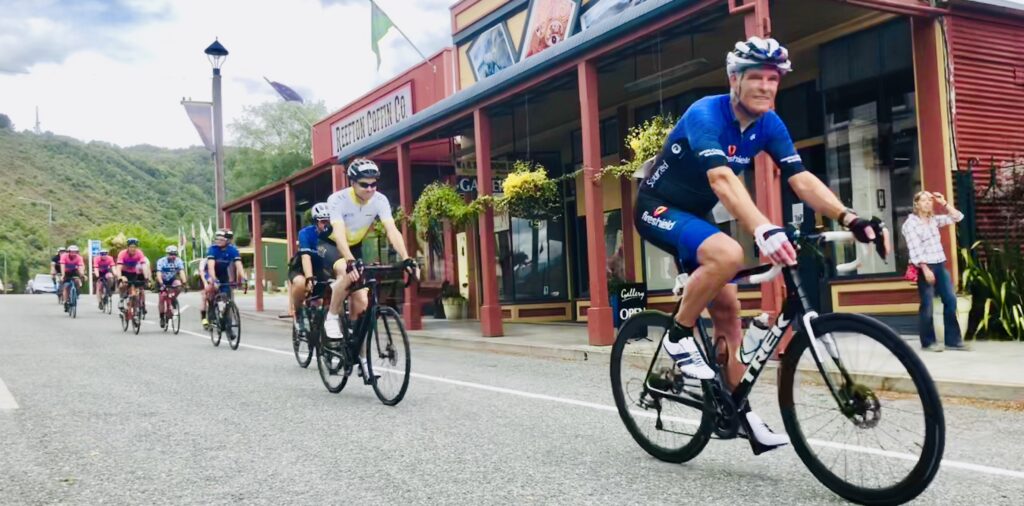
Mountain biking plays a big role in Reefton, for locals and visitors alike.
“It’s all about balance. You need socio-economic stability, but you also need to be mindful of the needs of the community,” notes Helen with a nod to many Reefton residents’ wish to maintain the town’s small size and quiet lifestyle despite its economic growth.
“Where else in the world, after a day of there not being a carpark to be had, can I have a chat in the middle of the main road at 5pm in the afternoon? That’s exactly the kind of town I want to live in.”
JOHN BOUGEN
Paul agrees that it’s the diversity of businesses, skills and ideas that makes the town sustainable, plus the variety of groups and skill sets that are coming together to push forward ideas and projects, citing the current restoration of the community theatre, funded by the Buller District Council as one example. John Bougen, another local resident deeply invested in Reefton’s revival, adds that this fund has also extended to the Reefton Racecourse where the Grandstand and Tearooms are receiving further much needed refurbishment, as well as the restoration of the historically important Railway Station and Oddfellows Hall. Furthermore, another recently received substantial grant will see the Strand Revitalization Project completed, which was initiated 25 years ago and will finally link the town to the Inangahua River on which it was founded.
“It’s a knock-on effect. Once people see that something is working, they want to be part of the success,” says John. “And it’s amazing how you can find the funds you need once you have proven you are actually doing good things for the community.”
Building from strengths
“Authenticity is fuelling Reefton’s future.”
NZ BUSINESS MAGAZINE, DECEMBER 2019
It’s the entrepreneurial spirit of locals and newcomers alike that has been another catalyst in Reefton’s return to vibrancy, agree Helen, Paul and John. One example of a home-made success is the popular Reefton Distilling Co which, founded by another returnee Reeftonian, Patsy Bass, has gained an excellent reputation, and business success, selling their goods both nationally and internationally.
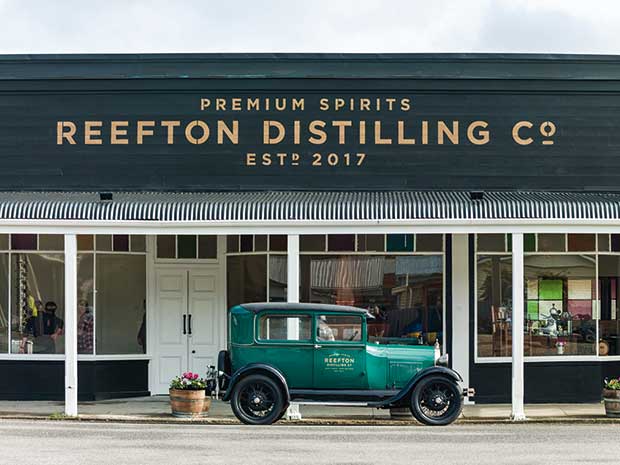
The Reefton Distilling Co is housed in one of Reefton’s original buildings which has been carefully restored to accommodate the working distillery, tasting bar and retail store.
Another is John himself: the self-made businessman turned Buller District Councillor who fell in love with the place and its people when he moved to Reefton five years ago. “People here on the West Coast are so friendly and have such a positive, cheery disposition. Things are possible here, people are open to ideas.”
Humble about his own contributions to Reefton’s recovered economy, John is quick to point out that the community has always been the main driver behind returning Reefton to its old glory:
“The fire has been lit a long time ago -all I have done in the last five years is put a bit more petrol on.”
JOHN BOUGEN
John’s can-do attitude and investment in the restoration and re-purposing of heritage buildings in town have continued on from the Shop Front Project to others, like the repainting of the old mining school, the complete rebuild of the original gaol, along with a number of shops on Broadway, Reefton’s main street. These heritage buildings are now a stunning backdrop to every visitor’s holiday photos and have moreover created local jobs and sparked ideas for new ventures, from the likes of another local who is now building tiny houses at Reefton’s old mill, and Andy and Sarah Parker who have boldly and faithfully restored the old Knox Church.
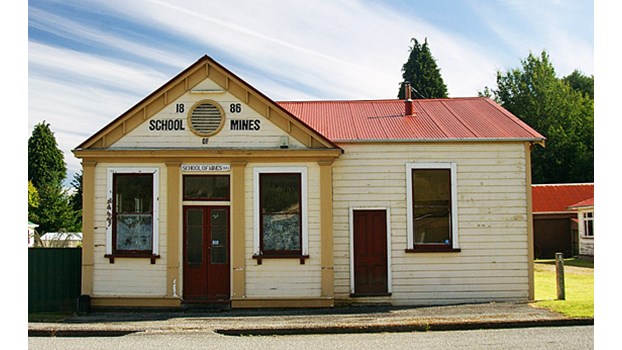
The restored School of Mines building.
“Reefton is now thriving and people are committed to keeping this going,” says Paul. John adds that the shared vision is very much to enable and support ideas to keep that momentum going: “The great thing about the West Coast is that you just do it. We have everything here – opportunities are abundant.”
And it’s not just business owners who have been ramping up the pace in Reefton. Local artists and artisans have been busy creating a burgeoning creative and social hub. Their contribution is apparent all over town, including the Friday nights at the Workingmen’s Club which now hosts a vibrant scene. The local galleries have never been busier, attracting more and more visitors. “Reefton has become a real go-to place,” agree John and Paul.
A long-term vision for lasting change
This is also reflected in local government’s attitude towards supporting bigger projects and the continuous building up of skills amongst the community. “There is lots of enthusiasm around the Council table,” says John. “Now is really Reefton’s time.” He adds that while Reefton has a core team of leaders doing a great job at working on the ongoing development of their town, they are also mindful to “leave the door open for other people to come in”.
“There’s always been different key people at different times who have carried things through – everyone brings a different skill to the table.”
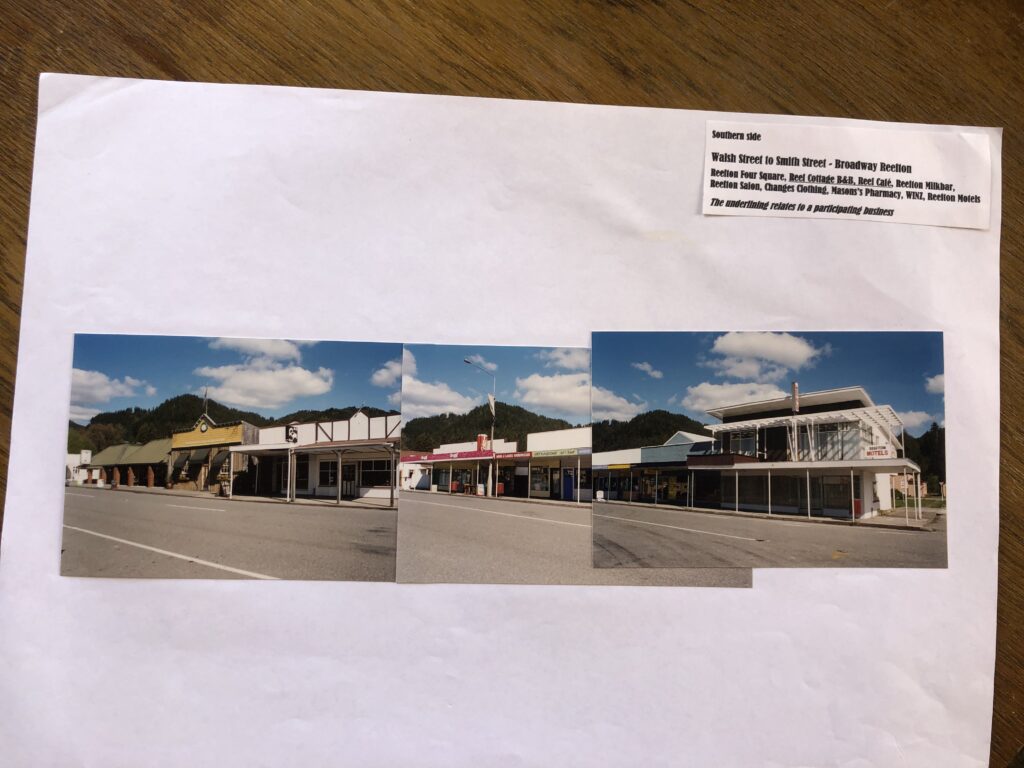
Reefton’s Walsh to Smith Street in 2002.
The same area, almost 20 years later: Walsh to Smith Street in 2020.

Paul adds that there has always been real stand-outs among the people who have dedicated their time and energy to their community: “It’s often me who gets interviewed for the papers but without people like Ronnie Buckman for example, we could not have achieved what we have. Ronnie has been pulling cords behind the scenes all these years. Not only was she our first Visitor Centre Manager back in the 90ies and then stepped into promoting our town and cause, she’s been essential to building the relationships between the community and the funding agencies. She’s a local, a real ‘West Coaster’, she’s been our connector for the Revival Project all along.”
All agree that everyone needs to be committed to the long haul – maintaining a flourishing community and a buzzing town is an ongoing project, not one that’s finished after a few years work. Working together as a community is all about finding the right balance between people’s needs and wishes for their town, and the economic realities of keeping everyone in jobs and business. Community and local business development must go hand in hand.
“It’s important to have these constant conversations, is it working, or is it not working? And making adjustments as you go along.”
PAUL THOMAS
Video: The Shirley Village Project
Located around 5km north-east of Christchurch’s city center, Shirley is a vibrant multicultural suburb that’s focused on working collaboratively to make their community even better.

